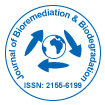Investigating the Electrical Conductivity of Biofilms: Mechanisms, Implications, and Applications
*Corresponding Author:Received Date: Mar 03, 2025 / Accepted Date: Mar 30, 2025 / Published Date: Mar 30, 2025
Citation: Horsecar E (2025) Microbial Mechanisms in Heavy Metal Bioremediation:A Sustainable Approach to Environmental Cleanup. J Bioremediat Biodegrad, 16:671.DOI: 10.4172/2155-6199.1000671
Copyright: © 2025 Horsecar E. This is an open-access article distributed underthe terms of the Creative Commons Attribution License, which permits unrestricteduse, distribution, and reproduction in any medium, provided the original author andsource are credited.
Abstract
Heavy metal contamination of soil and water bodies has become a significant environmental issue due to industrial
activities, mining, and urbanization. Traditional methods of remediation, such as chemical precipitation and physical
extraction, often present high costs, limited efficiency, and environmental risks. In contrast, bioremediation, particularly
through microbial mechanisms, offers a more sustainable and cost-effective solution. Microorganisms possess various
metabolic pathways that enable them to detoxify, transform, or immobilize toxic heavy metals, making them invaluable
in addressing contamination. This review explores the microbial mechanisms involved in heavy metal bioremediation,
including bioaccumulation, biosorption, and biotransformation. Additionally, the challenges and future directions of
microbial bioremediation are discussed, emphasizing the need for advanced research to optimize and scale this
technique for environmental cleanup.

 Spanish
Spanish  Chinese
Chinese  Russian
Russian  German
German  French
French  Japanese
Japanese  Portuguese
Portuguese  Hindi
Hindi 
